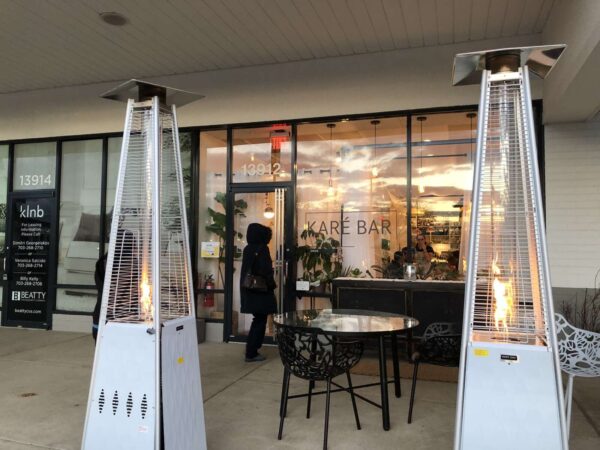
Spurred by the pandemic, outdoor dining in Fairfax County is likely here to stay.
The county is considering a proposal to formalize standards and regulations for outdoor dining in parking areas that were first introduced during the pandemic.
The existing ordinance — which ends in March 2024 after the county concluded its state of emergency on March 1 — allows any existing restaurant, food court, brewery, winery, distillery or tasting room to provide outdoor dining without individual approval.
The county is moving to permit outdoor dining as an accessory use, but may not include permanent structures, according to a presentation by Lily Yegazu of the county’s Zoning Administration Division. The Fairfax County Board of Supervisors discussed the draft proposal at a land use policy committee meeting on Tuesday (April 25).
Dining would be limited to 50% of the indoor dining area, with hours of operations matching the business’ hours. It would largely be restricted before 7 a.m. and after 10 p.m. if the establishment is next to a single-family development.
Board of Supervisors Chairman Jeff McKay noted that few concerns about outdoor dining — including noise impacts — have surfaced since the pandemic.
“Very few [issues]…I can’t think of any, honestly, since this has been put into place,” McKay said, adding that outdoor dining is “more popular now than it ever was before the pandemic.”
Applicants would pay a one-time application fee of $205 to allow outdoor dining in parking areas.
Providence District Supervisor Dahlia Palchik suggested the county should clearly distinguish between what permanent and temporary structures are allowed.
Staff emphasized that businesses can still apply to create permanent outdoor areas like patios or permanent pergolas through the county’s permitting process. The current proposal simply creates a catch-all policy for outdoor dining.
Hunter Mill District Supervisor Walter Alcorn encouraged the county to find ways for outdoor seating that faces the Washington & Old Dominion Trail.
“I think there certainly is customer interest,” Alcorn said.
Staff said the proposal is slated for public outreach meetings through the summer, tentatively followed by the board’s approval in the fall.
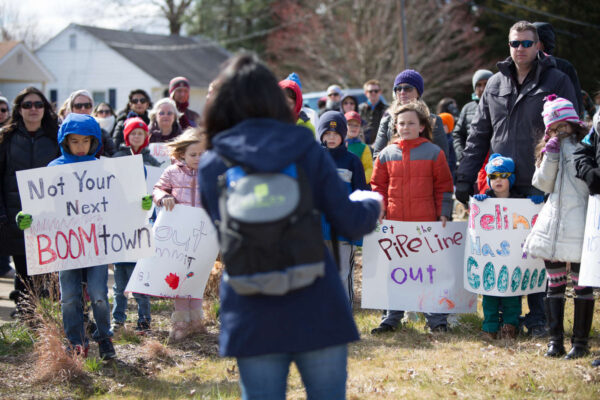
Cheers went up after the Fairfax County Board of Zoning Appeals (BZA) ruled last year that a natural gas pipeline planned through the residential neighborhood of Pimmit Hills will need to be reviewed and approved by the county.
However, even when proposing that decision on Feb. 2, 2022 after a multi-day public hearing, BZA Vice Chairman James Hart acknowedged that the case over the sixth phase of Washington Gas’ Strip 1 Tysons project was likely headed to court.
That court date will arrive this month. The utility company’s lawsuit seeking to vacate the board’s decision will go before a Fairfax County Circuit Court judge for a trial on April 25 and 26, spurring Pimmit Hills residents to rally together once again in opposition to the pipeline.
“We’re concerned citizens, you know. It’s our neighborhoods, our streets, our children, our playgrounds, our schools,” said Kurt Iselt, one of four residents named as defendants in the lawsuit after they brought the case to the BZA.
The challenged pipeline segment is the last stage of a push by Washington Gas to upgrade its natural gas infrastructure in the Tysons area, replacing a 14-inch-wide line with a 2-feet-wide, high-pressure one.
In the works since 2012, the overall project will span approximately five miles from Tyco Road to a regulator station at the Pimmit Drive and Route 7 (Leesburg Pike) intersection.
Phase six will be routed from Peabody Drive to Cherri Drive and Pimmit Drive to Route 7 — right through the heart of Pimmit Hills. Washington Gas had considered an alternate route along Magarity Road and Route 7 but said construction would take longer and bring more disruptions.
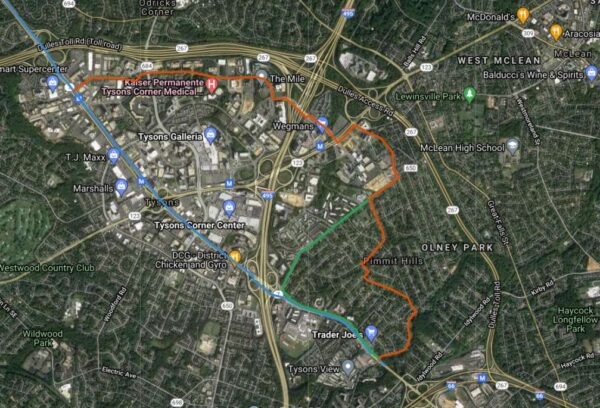
After initially denying it twice, the Virginia Department of Transportation approved a permit for the project in 2019, despite opposition from residents and local and state politicians representing the area.
At the request of Islet and fellow residents Christina Chen Zinner, Sarah Ellis and Lillian Whitesell, a county zoning administrator reviewed the project and decided it qualified as a “light utility facility” exempt from local regulation per the county’s zoning ordinance (page 241), which hadn’t yet been struck down.
The lawsuit by Washington Gas argues that the BZA lacked the authority to partially overturn the zoning administrator’s determination and require the project to obtain a special exception permit and undergo a 2232 review.
“Phase 6 is part of [the] Petitioner’s ‘ordinary distribution system’ that delivers natural gas to its customers and located in a VDOT right-of-way. Accordingly, Phase 6 is exempt from the zoning ordinance,” the petition filed on March 3, 2022 states, asserting that the BZA’s decision violated “decades of precedent” and state law. Read More
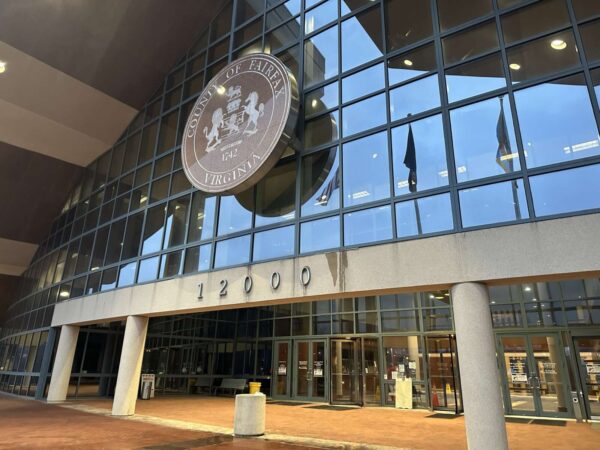
The Fairfax County Board of Supervisors is going to take a second stab at its ambitious Zoning Ordinance Modernization Project (zMOD) after Virginia’s Supreme Court struck down the prior approval.
The county’s zMOD overhaul involved a variety of sweeping changes to the zoning ordinance, from loosening limits on accessory dwelling units to changes in regulations governing flags and flagpoles.
Unfortunately for the Board of Supervisors, the Virginia Supreme Court voided the 2021 approval of zMOD because the meeting where it was approved and prior public hearings were held virtually, which it said violated the county’s Virginia Freedom of Information Act requirements.
The ruling raised questions about development and land use decisions made in the wake of the zoning code update, though Virginia passed a new law last year that loosened restrictions on virtual public meetings.
Tomorrow (Tuesday), the board is set to start the public hearing process to give zMOD approval another go. An administrative item at the board’s meeting for tomorrow would grant “authorization to advertise public hearings on the readoption of the zoning ordinance.”
According to the docket:
If the Board’s 2021 adoption of the zMOD Ordinance was void, so was the contemporaneous repeal of the 1978 Zoning Ordinance (as amended), leaving that earlier Ordinance still in effect. As a result, new public hearings are required for reconsideration of the zMOD Ordinance as previously adopted on March 23, 2021. And while subsequent Zoning Ordinance amendments are not addressed in the opinion, staff recommends that they be included as part of the complete Zoning Ordinance being considered.
Unsurprisingly, the county executive is recommending that the board authorize advertisement of public hearings for an ordinance it already approved in a 7-3 vote on March 23, 2021.
If the advertisement of public hearings is approved, those will come at the May 3 Planning Commission meeting and the May 9 Board of Supervisors meeting, meaning zMOD could be reapproved less than two months after the original approval was struck down.
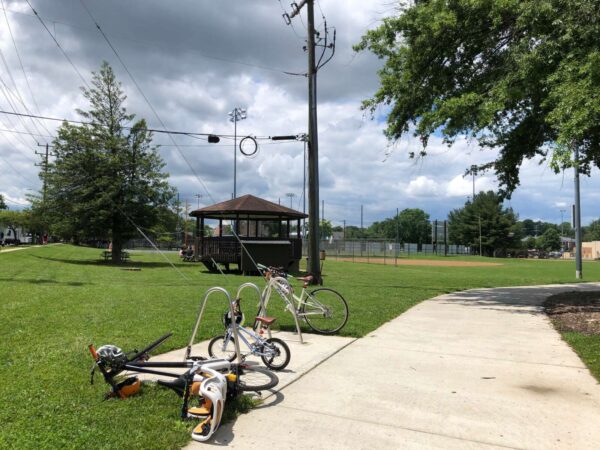
Aware of a growing need for more variety in its housing options, the Town of Vienna is taking a harder look at its standards for multifamily residential development.
Changes currently under consideration include the introduction of minimum parking requirements for bicycles, according to draft regulations for apartments, townhouses, and other residences allowed in a new residential multi-unit (RMU) zone.
The Vienna Town Council will discuss the draft at a conference session tonight (Monday).
As part of a general overhaul of the zoning code, the town’s first in over 50 years, staff have proposed requiring multi-unit residential developments to provide three bicycle racks or six spaces for every 2.5 dwelling units to serve residents. Three racks will also be needed for every 50 units to accommodate visitors.
The suggested bicycle parking standards are based on requirements used by Falls Church City, according to the draft.
The revised code will also establish standards for parking lot landscaping and screening, outdoor lighting standards and loading areas, though loading spaces won’t be required for townhouses, duplexes and cottage courts.
For other multifamily developments, the draft would require one loading space per 50 units, with each space measuring at least 25 feet long and 15 feet wide. Right now, Vienna doesn’t dictate a specific number of spaces for different land uses, and the size varies based on the size of the building.
The need for updated multifamily residential regulations became clear last year during discussions about the proposed conversion of the Vienna Courts offices into duplex condominiums. The project’s eventual approval in December came after weeks of the developers, the town council and residents haggling over parking and open space to reduce its lot coverage.
Vienna’s zoning code overhaul — known as Code Create Vienna — has been underway since July 2020. Amendments giving residents more flexibility for outdoor decks were approved last June, but public hearings on the overall draft code aren’t anticipated until this fall.
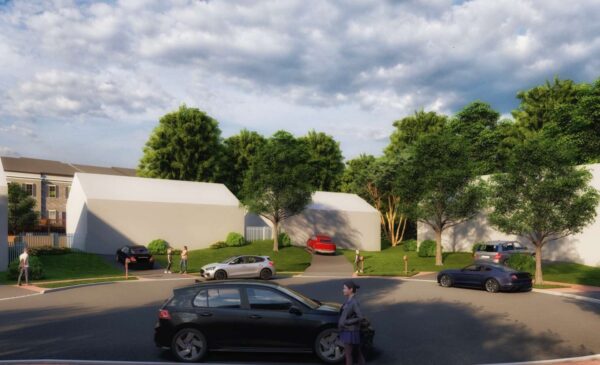
The amount of residential development on Villa Park Road in Springfield could see a boost if Fairfax County approves a proposal to increase the number of houses allowed in the area.
A community meeting is on the proposal is slated for April 17. The proposal, if approved, would increase the density allowed by the county’s comprehensive plan in the Springvale Community Planning Sector from 4-5 dwelling units to 8.5 dwelling units per acre.
JR Real Estate Group wants to develop two vacant parcels fronting Wesley Road and next to Villa Park Road into a 42-unit townhouse development, according to the application, which has been under county review since September 2021.
“The parcels have remained vacant for years and only recently been consolidated as they emerged from bankruptcy by the owner,” an updated statement of justification from March 17 says. “The present proposal represents the best opportunity in the near term to meaningfully reinvest in the community while also advancing broader county policy objectives.”
A central spine road would anchor the Towns at Villa Park, alongside two parks on site to buffer the new community from a single-family development on the west side of the property. Roughly 2.7 acres of open space are proposed — almost triple the minimum requirement set by the county, according to the application.
The applicant plans to contribute 0.5% of the projected sales price of the units to the county’s housing trust fund.
The meeting begins via Zoom at 7 p.m. Information is available on the county website for the proposed plan amendment.
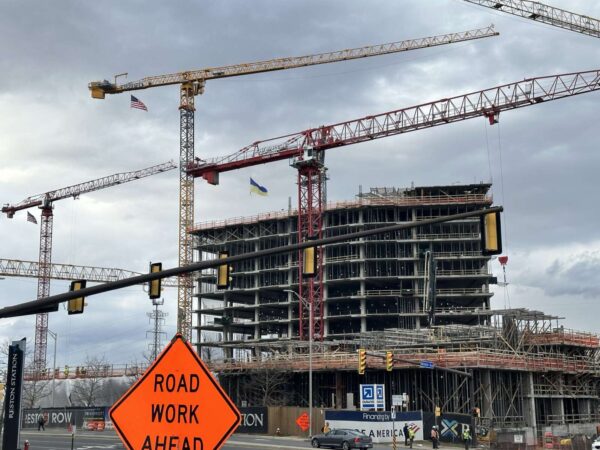
Fairfax County staff have pared down the draft of Reston’s proposed comprehensive plan from 180 pages to 133.
At a Fairfax County Planning Commission workshop on March 30, staff walked through their amendments to the proposed plan, a process that kicked off more than two years ago with a community-driven task force initiated by Hunter Mill District Supervisor Walter Alcorn.
The task force approved draft recommendations on Aug. 28 after 58 public meetings, significant public feedback and rigorous debate. Hunter Mill District Supervisor Walter Alcorn convened the task force after he took office in 2020.
Overall, staff’s version of the plan avoids policy and prescriptive language in specific areas, particularly land use. It also combines chapters about equity and community health — previously created by the task force as separate chapters — under the umbrella of “new town elements.”
St. Clair Williams, senior planner with the county’s Department of Planning and Development, said the change was intended to avoid language that could clash with current county policies, particularly the county’s One Fairfax policy on equity.
“There were concerns raised regarding new chapters. Was it created new policy or was it something that was exceeding current county policy?” Williams said.
Revising the community health section was challenging due to the lack of a formalized, countywide health policy that the plan could use as a basis, he said.
Hunter Mill District Planning Commissioner John Carter emphasized that staff’s edits are intended to “implement…instead of create new policy.”
“We’ve tried to emphasize the use of active verbs,” Carter said.
A road network near Association Drive was revised by staff in order to allow flexibility in the future. It now highlights that an east-west connection between Soapstone Drive and Association Drive should avoid tree areas.
The county is considering a major site-specific plan amendment (SSPA) that would redevelop the buildings on Association Drive into a mostly residential project.
Braddock District Commissioner Mary Cortina said she hoped that nomination would preserve some of the historic aspects of the site.
Other major land use decisions in Reston’s transit-oriented areas were removed from the plan. Those proposals are currently being pushed through the SSPA process, which includes several redevelopment pitches for major projects in Reston.
The plan also adds additional water retention and quality targets for new development. Other general elements related to air, climate, resiliency and invasive plant species were removed, though the new draft has sections on vegetation and “green buildings.”
Staff also revised language guiding the number of full-size athletic fields in Reston’s TSA, saying that the “equivalent of 12 fields” should be provided.
“Staff had identified some of the challenges with finding sufficient space for full-size fields,” Williams said.
No land use changes for Reston’s golf courses are recommended — a major point of contention in the community.
For affordable housing, the plan ups the bar on requirements for developers on Reston projects.
In Reston’s transit station areas, affordable housing requirements for rental workforce dwelling units (WDU) are higher than surrounding areas. In the TSAs, 12% of units should be set aside as rental WDUs — half of which should target households making between 71 and 80% of the area’s median income.
The countywide policy requires that 8% of rental units in residential developments be set aside as WDUs.
Staff will release their final version of the plan on May 11. Public hearings are slated before the planning commission on June 14 and June 28, with potential action on the latter date. Meetings are tentatively scheduled with the Board of Supervisors this month, though the schedule is subject to change.
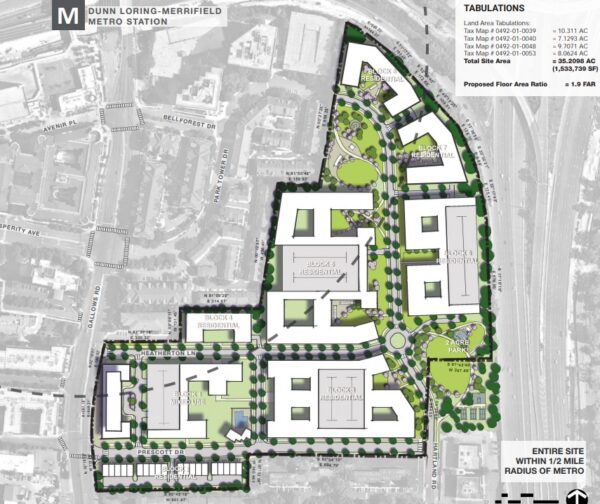
Redevelopment proposals in the Merrifield area will likely get high-priority consideration by Fairfax County planners, as the county nears the finish line of its reconfigured site-specific plan amendment (SSPA) process.
After a nearly four-hour-long workshop on Thursday (March 23), the Fairfax County Planning Commission gave its support to staff’s recommendation that the pitches for Merrifield and an AT&T office site in Oakton be designated as “Tier 1” in the SSPA work program.
That means they would get top priority in terms of resources and scheduling. County staff are reviewing 68 Fairfax County Comprehensive Plan amendment nominations and have recommended about 50 for inclusion in the work program, which will be finalized by the Board of Supervisors on April 11.
The Merrifield proposals all replace older, mostly commercial properties with mixed-use housing, leading a couple of commissioners to warn against leaning too heavily on current market trends when determining what development to pursue.
“Things go in cycles, and we have to be attuned to how those cycles change, when they change and why they’re changing,” Dranesville District Commissioner John Ulfelder said. “Sometimes, we’re not very good at that.”
Community members who testified last week generally supported the Merrifield nominations, describing the area around the Dunn Loring-Merrifield Metro station as ideal for housing that supports modes of travel other than private cars.
Prosperity Business Campus
The response to a proposed transformation of the 41-acre Prosperity Business Campus into seven blocks of mid-rise, multifamily residential buildings and townhouses was particularly enthusiastic.
Representatives of the Coalition for Smarter Growth (CSG) and YIMBYs of Northern Virginia said their groups ranked this nomination at the top when reviewing the SSPA submissions.
“The increase in parks actually reduces the impervious surfaces that are in this area as well, so it’s good for the environment,” YIMBYs member Aaron Wilkowitz said. “It’s good from the transit perspective, it’s good from the housing perspective. Across all the things that the county cares about, this proposal is critical to meeting those needs.”
The proposal adds an estimated 1,273 units of housing and 183,000 square feet of nonresidential uses, including some ground-floor retail. It also provides over 12 acres of publicly accessible park space, preserves the adjacent Long Branch stream valley and updates a pedestrian crossing over the stream.
Two residents of Dunn Loring Village, a townhouse complex west of the stream, said they’re “excited” about the potential project, though one advocated for better stormwater management in light of the recent I-66 widening.
The resident noted that Long Branch flows into Accotink Creek and, eventually, Lake Accotink, which is at risk of disappearing due to sediment build-up.
“Please consider…anything that can be done to reduce the impervious footprint, experimental ways to reduce that footprint,” he said.
Dunn Loring at Merrifield Station
Malkin Properties has proposed replacing the 35-acre garden apartment community at 8130 Prescott Drive with eight blocks of mixed-use development, including 2,300 residential units and up to 700,000 square feet of nonresidential uses. Read More

A day after neighboring Arlington County made waves by ending single-family exclusive zoning, Fairfax County saw its own zoning reforms reversed two years after they were approved.
The Virginia Supreme Court declared the county’s Zoning Ordinance Modification Project (zMOD) void yesterday (Thursday) because the new code was adopted at a mostly virtual meeting — a ruling could have consequences for other actions taken during the first years of the pandemic, as noted by Inside NoVA, which first reported the decision.
The county is now operating under its previous zoning ordinance, which had been in place since 1978, according to the zoning administration division’s website.
“We are currently evaluating the Virginia Supreme Court decision and considering our options,” Tony Castrilli, the county’s director of public affairs, said. “In the meantime, the 1978 Zoning Ordinance is presently in effect and available for reference on the County website.”
In a 29-page opinion, Justice Wesley Russell sided with four residents who argued that the Fairfax County Board of Supervisors violated the Virginia Freedom of Information Act’s open meeting requirements by not holding an in-person public hearing or vote.
The county contended that an ordinance adopted on April 14, 2020 gave it the flexibility to hold public meetings on the zoning update and other subjects electronically during the Covid state of emergency.
The Supreme Court disagreed that the ordinance allowed the county government to conduct all regular business electronically, finding that the zoning update doesn’t qualify as “necessary to ensure the continuation of essential functions and services.”
“The modification of a 40-year-old zoning ordinance after a five-year revision process does not satisfy this standard,” Russell wrote. “It is not a time-sensitive matter, and its adoption is not and was not necessary to allow the County to continue operations.”
The residents behind the lawsuit — David Berry, Carol Hawn, Helen Webb and Adrienne Whyte — filed a complaint in Fairfax County Circuit Court on March 5, 2021 seeking to prevent the board from adopting zMOD at a public hearing on March 9, 2021.
The circuit court denied the request and ultimately dismissed the complaint on Sept. 9, 2021, stating that it had been rendered moot by the adoption of zMOD on March 23, 2021 and that the county board’s emergency powers gave it the authority to act at an electronic meeting. Read More
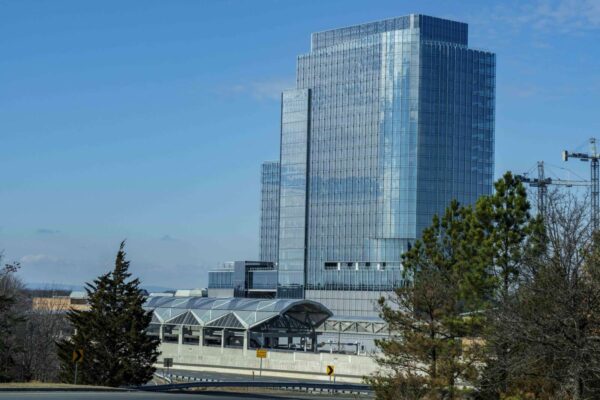
Pitches from developers for land use changes in Reston’s transit areas are on a different track as the county considers dozens of similar nominations throughout Fairfax County as part of its Site-Specific Plan Amendment (SSPA) process.
Unlike other areas of the county, Reston Transit Station area applications have been set aside for special study and deferred until a years-long process to update Reston’s Comprehensive Plan is completed, according to the county.
Other applications throughout the county are being placed in a draft work program that will determine how their study is prioritized. In the Dranesville District, for example, applications for the Innovation Center area were placed in the first tier — the highest priority — of the program.
In a statement, Hunter Mill District Supervisor Walter Alcorn said the draft work program identifies Reston site nominations for future study after the overall plan amendment is completed.
“This process will ensure that the latest Comprehensive Plan for Reston is used in the review of proposed site-specific changes in the area,” Alcorn said.
Most nominations in Reston’s transit area pushed for more residential uses in lieu of or in addition to office uses.
The county plans to publish a staff report on its recommendations this spring, followed by a series of public hearings before the planning commission and Board of Supervisors in the summer. Adoption of the proposed changes is also expected this summer.
The effort first kicked off in January 2020.
The next planning commission workshop on the proposed Reston comprehensive plan is set for March 30 at 7:30 p.m. and will be streamed on Channel 16.
The Hunter Mill District received the highest number of SSPA nominations. Overall, the county received 75 nominations.
The Board of Supervisors selected the nominations currently under review by staff and the planning commission on Dec. 6. This review is evaluating if the proposals are consistent with county policies and priorities relative to other planning considerations.
The planning commission has been holding public workshops on the various nominations throughout March, concluding on March 23 with one focused on proposals in the Hunter Mill and Providence districts.
“We anticipate the final vote will be at the March 29 Planning Commission meeting,” said Leanna Hush O’Donnell, planning division director for the county’s Department of Planning and Development. “The final screening decision point will be the Board’s action on the work program, scheduled as an action item on April 11.”
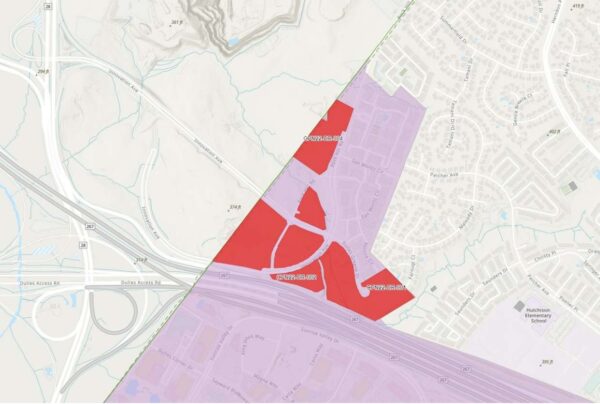
(Updated at 12:05 p.m.) Fairfax County planners agree that proposed development changes to the Innovation Center area are a top planning priority in the county’s ongoing Site-Specific Plan Amendment (SSPA) process.
At a meeting on Thursday (March 9), the Fairfax County Planning Commission voted to preliminarily place the Innovation Center Transit Station Area (TSA) in the top tier of the county’s SSPA work program, which sets the framework for the county’s review of comprehensive planning studies and plan amendments.
All three nominations in the Innovation Center TSA seek more density and more residential uses than originally planned.
Dranesville District Planning Commissioner John Ulfelder said the area is need of closer examination and focused work by the county.
“This is an important area now that the Silver Line is open and operating,” Ulfelder said. “We really need to play close attention to it as soon as possible in order to make it viable and to maximize the appropriate uses there.”
The current SSPA cycle kicked off with applicants submitting about 70 nominations last year. Ones formally accepted for review by the Board of Supervisors in December are now being screened and evaluated.
In a white paper released earlier this month, county staff organized the nominations in three tiers, with the top tier featuring those located in key development areas and identified as the highest priority for staff resources and timing.
So far, areas flagged as Tier 1 priorities include Fair Lakes, the Franconia triangle between Beulah Street, Franconia Road and Grovedale Drive and the Innovation Center TSA north of the Dulles Toll Road.
In the Innovation Center TSA, Peterson Companies is seeking the county’s permission to add 500 apartment units — a mix of which would be affordable — and a possible child care center at 13500 Dulles Green Drive. The project, called Innovation Center, would also include a county-owned parcel.
The Innovation Avenue plan for 2214, 2205, and 2210 Rock Hill Road seeks to boost the intensity of development near the former Center for Innovative Technology (CIT) office building and remove limits on the percentage of residential and office uses in the mix of uses.
A similar development called Rock Hill seeks to switch the development plan to mostly residential uses near the Innovation Center Metro station.
All three applications would be the focus of a combined study, according to staff.
The complexity of the proposed plan at Rivana at Innovation Station — which includes Loudoun County — requires close study, said Hunter Mill District Planning Commissioner John Carter.
Franconia District Planning Commissioner Daniel Lagana emphasized the county’s need to continue collaborating with Loudoun County as planning moves forward, particularly coordination within the existing and future road networks.
Lagana said he was pleased to learn that coordination is ongoing.
“When something happens in the city of Alexandria…we sort of kind of pay the price and I’m sure kind of vice versa,” Lagana said.
Of the 75 nominations submitted for review in October, 68 have moved forward for evaluation. The planning commission has a final workshop on March 23 and a mark-up session on the work program planned for March 29. The program will face a final vote by the Board of Supervisors on April 11.

